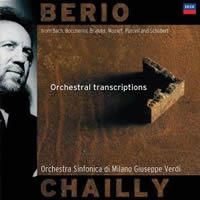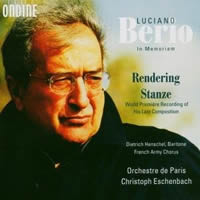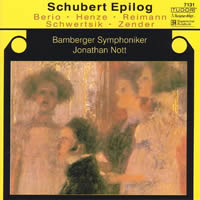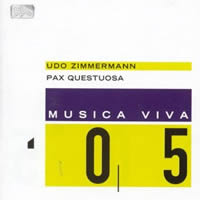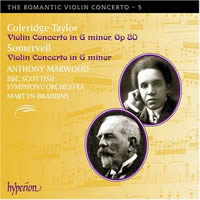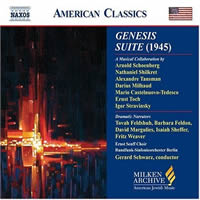Anomalies Pleasant and Surprising
|
Grant Chu Covell [April 2006.]
“Berio: Orchestral Transcriptions.” H. PURCELL / L. BERIO: The modification and instrumentation of a famous hornpipe as a merry and altogether sincere homage to uncle Alfred (1969); J.S. BACH / L. BERIO: Contrapunctus XIX (2001); L. BOCCHERINI / L. BERIO: Quattro versioni originali della “Ritrata notturna di Madrid” sovrapposte e trascritte per orchestra (1975); W.A. MOZART / L. BERIO: Divertimento für Mozart: 12 Aspekte der Arie “Ein Mädchen oder Weibchen wünscht Papageno sich” (1956); F. SCHUBERT / L. BERIO: Rendering (1988-90); J. BRAHMS / L. BERIO: Sonata for clarinet and orchestra in F Minor, Op. 120, No. 1 (1986). Fausto Ghiazza (clar.), Orchestra Sinfonica di Milano Giuseppe Verdi, Riccardo Chailly (cond.). Decca 476 2830 (http://www.deccaclassics.com/). Distributed in the US by Universal (http://www.universalclassics.com/). “Luciano Berio In Memoriam.” Luciano BERIO: Rendering (1988-90); Stanze (2003). Dietrich Henschel (bar.), French Army Chorus, Orchestre de Paris, Christoph Eschenbach (cond.). Ondine ODE 1059-2 (http://www.ondine.net/). Distributed in the US by Koch (http://www.kochdistribution.com/). “Schubert Epilog.” Luciano BERIO: Rendering (1988-90); Aribert REIMANN: Metamorphosen über ein Menuett von Schubert, D. 600 (1997); Hans Werner HENZE: Der Erlkönig, Orchesterfantasie aus “Le Fils de l’air” (1996); Hans ZENDER: Schubert-Chöre 1-4 (1996); Kurt SCHWERTSIK: Epilog zu “Rosamunde,” Op. 33 (1978). Carsten Süss (ten.), Chor der Bamberger Symphoniker, Bamberger Symphoniker, Jonathan Nott (cond.). Tudor 7131 (http://www.tudor.ch/). Distributed in the US by Forte Distribution (http://www.fortedistribution.com/). Berio may have been the postwar generation’s most sentimental if not most wistful composer. Unlike many of his peers, he acknowledged music’s history and would freely adapt, orchestrate and reinterpret the music of others, as well as his own. Chailly’s first-rate sequence of transcriptions collects some first performances and — to judge from recording availability — one standard. In the 62-second Purcell miniature crafted for Dr. Alfred Kalmus, the director of Universal Edition’s London outpost, snare drum joins flute, clarinet, viola, cello and harpsichord. Equally brief, but satisfying the mid-1950s need in new music to abrade and distill just about everything, Berio’s Mozart variations never expose the theme under consideration. The Boccherini effort superimposes four versions of the same piece. No development, just a pleasant tune, “Ritrata notturna di Madrid,” shouted to the skies. Evident upon comparing Berio’s own recording (RCA 09026-68894-2), Chailly’s lighter, slightly impish touch allows the music to expand and soar. The Bach transcription is miraculous. More romantic than Webern, less gushy than Stokowski, Berio burnishes Die Kunst der Fuge’s concluding incomplete fugue with warmth. Here and there he imitates organ stops as did Ravel in Boléro. Many consider this fugue a holy relic. Did the great contrapuntalist die after folding his name into the music? Whether the story is true or not, Contrapunctus XIX stops after the introduction of the B-A-C-H motive. Some interpreters step back as the incomplete voices drop out. Berio holds tones past the unfinished lines, ending his transcription with a dissonant smear. Berio’s Schubert and Brahms are the disc’s largest works. I heard the Brahms clarinet sonata orchestration in a hard-to-find recording (Cala CACD 1006) on the radio years ago. The orchestration sticks close to the Viennese master’s style, with some added measures to balance the forces. It’s a fine and fitting treatment. Given the paucity of viola concertos, are we due for an alternate recording? Berio’s Rendering has been worked over before, and now there are three new recordings to consider. (I confess to being very fond of the piece!) Chailly, the work’s dedicatee, nails the strange interludes best, liberating the tempo as if suspending time. Contradicting his first (Koch 3-7382-2 H1, O/P), Eschenbach’s new recording strives for uncontaminated Schubert, bleaching Berio’s intentionally disruptive counterpoint, celesta and queasy harmonies. I enjoy being fooled by Rendering’s stitching at every listen. In Chailly’s hands, the blurred passages reveal wisps of the other movements: In the bright Allegro a tiny line recalls Winterreise, which in turn reminds of Zender’s rethinking. Nott’s program sustains interest despite this rather stiff Rendering. Stanze, a five-poem cycle for baritone, chorus and orchestra, is Berio’s last completed composition. We hear texts by Paul Celan, Giorgio Caproni, Edoardo Sanguineti, Alfred Brendel and Dan Pagis rendered in dark hues. Brendel’s text — yes, the same Brendel — explores the idea that the Holy Ghost reveals itself in the Tritsch-Tratsch-Polka. Berio appropriates the requisite Strauss, but the effect is unexpectedly leaden. Given the seriousness Eschenbach imparts to Rendering, I suspect that Stanze could be less weighty despite Henschel’s persuasiveness. Not only because he died early and so full of promise or because the great song cycles progress from youthful optimism to suicidal despondency, in listening to Schubert I’m reminded that death is somewhere in the room. The composer’s last great works are resigned to its presence. I’m not sure why contemporary composers have been drawn to Schubert: Perhaps they find his innocence easy to contrast against their own times. Tudor presents five composers’ intriguing Schubert reworkings and reconsiderations. Given Schubert is in the lens, the solid performances are unexpectedly severe. The recording quality is also slightly clotted, especially evident in Henze’s whirlwind Der Erlkönig, which surely would have profited from greater clarity. Knowing Henze’s Seventh, the density of which builds to near panic levels, I had expected more oomph from this rapidly paced orchesterfantasie. Originally conceived for ballet but programmable independently, Schwertsik’s tender Rosamunde epilogue gradually progresses from dark to light as it reveals its Schubertian debt. Zender’s Schubert-Chöre 1-4 are intentionally less subversive than his Schubert’s Winterreise, though the third chorus teases with a wrong-key accompaniment. These four delicate settings for chorus and orchestra remind one of the short distance between early Mahler and Schubert. Süss’ feathery tenor in Zender’s Nachthelle transcription contributes contagious passion, most welcome on this generally sober disc. Reimann’s Metamorphosen for ten instruments visits the most audible destruction upon its Schubertian text through airy serial scouring. A miniature drama ensconced within its brief eight minutes, the Bamberger soloists perform friskily. A companion release, “Schubert Dialog,” with Mantovani, Rihm, Schnebel and Widmann, warrants examination (Tudor 7132). (While we’re here, Reimann’s Lear [DG 463 480-2] is a splendid operatic treatment of Shakespeare’s tragedy. Gerd Albrecht leads the Chor der Bayerischen Staatsoper and the Bayerisches Staatsorchster in this live recording from 1978 that sounds like it was taped just yesterday. Dietrich Fischer-Dieskau takes the lead in his accompanist’s opus; Julia Varady sings Cordelia. Imagine a serial opera with thundering climaxes, recognizable leitmotifs, microtonal inflections and excellent pacing.)
Udo ZIMMERMANN: Pax Questuosa (1982). Edith Wiens, Mechthild Gessendorf (sop.), William Cochran (ten.), Roland Hermann (bar.), Siegmund Nimsgern (bass). Chor des Bayerischen Rundfunks, Symphonieorchester des Bayerischen Rundfunks, Udo Zimmermann (cond.). col legno WWE 1CD 20085 (http://www.col-legno.de/). Distributed in the US by Qualiton (http://www.qualiton.com/). Volume 5 of col legno’s “Musica Viva” series. In the humanistic tradition of Mahler, Hartmann and Henze, Zimmermann’s “The Lamenting Peace,” a 52-minute large-scale oratorio, incorporates poems by St. Francis of Assisi, Czeslaw Milosz, et al. The serioso vocabulary, while employing dissonance, doesn’t come off as difficult. The marching pianos and some squarely built brass lines suggest Orff. The composer conducts the Bayerischen Rundfunks’ chorus and orchestra as he “bear[s] witness to sympathy for piece.” Zimmermann’s orchestra yields in the main to the five vocal soloists and chorus. Among aleatoric-sounding passages and the obligatory chimes, there are some excitingly powerful builds such as the Implorationes’ conclusion. But the last movement (Exclamatio II) contains an affront: A slowly-paced Dona Nobis Pacem emerges whole from the wispy texture. A sublime moment in Bach’s B-Minor Mass, this shoehorned interruption puts Zimmermann to shame.
“The Romantic Violin Concerto – 5.” Samuel COLERIDGE-TAYLOR: Violin Concerto in G Major, Op. 80 (1911); Sir Arthur SOMERVELL: Violin Concerto in G Major (1930). Anthony Marwood (violin), BBC Scottish Symphony Orchestra, Martyn Brabbins (cond.). Hyperion CDA67420 (http://www.hyperion-records.co.uk/). Distributed in the US by Harmonia Mundi (http://www.harmoniamundi.com/). Samuel COLERIDGE-TAYLOR: Violin Concerto in G Major, Op. 80 (1911); Antonin DVORAK: Violin Concerto in A Minor, Op. 53 (1879). Philippe Graffin (violin), Johannesburg Philharmonic Orchestra, Michael Hankinson (cond.). Avie AV0044 (http://www.avierecords.com/). Distributed in the US by Forte Distribution (http://www.fortedistribution.com/). It’s uncanny that the first two commercial recordings of the Coleridge-Taylor violin concerto emerged in 2005. First performed by Maud Powell in 1912, the concerto was the composer’s last major composition: Pneumonia felled him that year. The “coloured Dvorak,” as Powell had labeled him, had meant to employ spiritual tunes along the lines of Dvorak’s concerto. Oddly, several first movement passages recall Tchaikovsky’s Pathetique, but beyond that coincidence it will be a hard sell for repertoire-building. Graffin tackles the Coleridge-Taylor energetically. In the Dvorak’s last movement there’s the subtlest sense that the conductor, who seems to want to push forward, meets resistance from the Johannesburg players. Marwood and the BBC Scottish Symphony are altogether mellower. The tuneful Somervell concerto is a charmer, and Marwood’s sincerity advocates well. Despite Coleridge-Taylor’s logical pairing with Dvorak, most listeners may already possess a favorite recording of the Czech concerto. Hyperion’s disc with two unknowns is more attractive.
“Genesis Suite (1945).” Arnold SCHOENBERG: Prelude, Op. 44; Nathaniel SHILKRET: Creation; Alexandre TANSMAN: Adam and Eve; Darius MILHAUD: Cain and Abel, Op. 241; Mario CASTELNUOVO-TEDESCO: The Flood; Ernst TOCH: The Covenant (The Rainbow); Igor STRAVINSKY: Babel. Tovah Feldshuh, Barbara Feldon, David Margulies, Fritz Weaver, Isaiah Sheffer (speakers), Ernst Senff Choir, Rundfunk-Sinfonieorchester Berlin, Gerard Schwarz (cond.). Naxos 8.559442 (http://www.naxos.com/). Distributed in the US by Naxos (http://www.naxos.com/). Anything that lassos Schoenberg and Stravinsky into the same pen warrants consideration. Remembered today as a conductor of film scores and Gershwin premieres, Shilkret commissioned several émigré peers then residing in California (he himself was born in New York City). The Genesis Suite’s Nov. 18, 1945 premiere met with a lukewarm reception. Unmistakably a Hollywood product, its dissimilar styles would have bewildered. The $300 commission may have trumped inspiration: Schoenberg made quick work of his Prelude, starting on Sept 21, 1945 and completing it nine days later. (Stravinsky was secretly handed an extra $700 to headline the project.) Naxos’ notes reveal how several scores were destroyed when a fire consumed Shilkret’s archives. The Shilkret, Tansman and Toch movements were reconstructed by Patrick Russ. We also learn how Angel’s LP and CD issue (Angel 7243 5 67729 2 2 with Werner Janssen leading the Janssen Symphony Orchestra of Los Angeles, rec. 1946, O/P) combined separately recorded music with narration, mistakenly reordering the movements, and misattributing the narrator. For its recording, Naxos utilizes four voices, elevating an already hokey confection into something with the grandiloquence of an educational filmstrip about salt processing. The actors (including Get Smart’s Agent 99!) narrowly overwhelm the orchestra, though this release is far preferable to Angel’s composite recording with its ancient sound and too-earnest narration. Ironically, the most systematically composed movement, Schoenberg’s dodecaphonic prelude, represents chaos. Shilkret’s Creation starts from a dissonant blur before yielding to mellow soundstage harmonies. The narrated texts behave like commentary upon the passing scene. Inevitably listeners will look for sound paintings that aren’t there. Unlike Hadyn’s Seven Last Words, the interleaved text and music of which provide ample space for contemplation, these stories provide no time for reflection. Because its brevity prevents lingering sentimentality and overinterpretation, Milhaud’s contribution, Cain and Abel, is the most effective. Castelnuovo-Tedesco’s The Flood tackily raises the water level with the aid of a chorus. If I’m not paying close attention, Toch and Stravinsky’s movements blend together despite their differences. The front runners’ contributions aren’t among their best, and the others aren’t likely to spark revivals. Asked about his rival’s piece, Schoenberg’s blunt remark rings true: “It didn’t end, it just stopped.”
Bach, Berio, Boccherini, Coleridge-Taylor, Dvořák, Henze, Milhaud, Purcell, Reimann, Schoenberg, Schubert, Schwertsik, Somervell, Stravinsky, Tansman, Toch, U Zimmermann, Zender
[More (Dis)Arrangements, Grant Chu Covell]
[More
Bach, Berio, Boccherini, Coleridge-Taylor, Dvořák, Henze, Milhaud, Purcell, Reimann, Schoenberg, Schubert, Schwertsik, Somervell, Stravinsky, Tansman, Toch, U Zimmermann, Zender]
[Previous Article:
Denhoff, Grisey, Neuwirth]
[Next Article:
Chopin in Longview]
|
